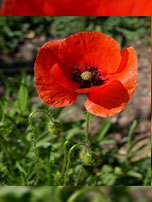SHAHEED KARTAR SINGH SARABHA AYURVEDIC MEDICAL COLLEGE & HOSPITAL
Affiliated to Guru Ravidas Ayurved University, Hoshiarpur Punjab
Affiliated to Guru Ravidas Ayurved University, Hoshiarpur Punjab

Botanical Name : Papaver rhoeas L.
Family : Papaveraceae
Introduction :
Papaver rhoeas L. (Papaveraceae), commonly known as corn poppy, is a cosmopolitan weed and edible plant capable of possessing biological properties, thus positive correlating with human health. The plant is also known as field poppy, flanders poppy or shirley poppy. It can be consumed raw or cooked, and has been traditionally used to treat nervousness, insomnia, digestive and respiratory disorders, baldness, eye infections, as well as measles treatment.
Names in different Indian languages :
Assamese : Rokta-posto
English : Common Poppy, Red Poppy, Flanders Poppy, Field Poppy, Corn Poppy
Hindi : Khas-khas
Others : Red Poppy, Flanders Poppy, Corn Poppy, Kaba (Manipuri), Common Poppy, Field Poppy
Synonyms :
Papaver commutatum Fisch., C.A.Mey. & Trautv.
Papaver insignitum Jord.
Papaver intermedium Becker
Papaver rhoeas var. strigosum Boenn.
Papaver rhoeas subsp. strigosum Simonk.
Papaver roubiaei Vig.
Papaver strigosum Schur
Papaver tenuissimum Fedde
Papaver trilobum Wallr.
Papaver tumidulum Klokov
Morphology :
Erect annual herbs, about 30-50 cm tall. Stem simple or sparsely branched, setose, caulescent, hirsute, covered with stiff bristles, about 1-3 mm long or rarely glabrous. Leaves pinnatisect, pinnatipartite and pinnatifid about 6-20 x 3-9 cm across, basal leaves pinnatisect, ovate in outline, margin ciliate, dentate, segments linear, apex acute, terminal lobes larger than the lateral lobes, basal and lower leaves, larger and less segmented, and petiolate, upper cauline leaves becoming smaller, base amplexicaul, more dissected, sessile towards the shoots. Peduncles erect, hirsute or coarsely tuberculate hairy, about 12-25 cm long. Flowers bisexual, solitary, terminal, bowl shaped, about 6-10 cm across, red with black at the base, flower buds obovoid, somewhat cup shaped or blunt at the apex, bristly about 1.5-3 x 1-2 cm across, Sepals 2, free, deciduous, ovate-orbicular, early caducous, bristly, petals 4, broadly obovate, suborbicular, red with black blotch at the base, about 3-5 x 3-6 cm across. Stamens numerous, about 10 mm long, filaments filiform, slender, purplish, anthers elliptic, about 1 mm long. Ovary ovoid, unilocular, superior, glabrous, about 7-10 mm long, ovules numerous, stigmatic rays disc yellow, opposite to placentas, about 8-13. Fruits capsules, oblong-obovoid, cylindrical, about 10-18 x 6-9 mm across, dehiscing by subapical pores or persistent disc. Seeds many, bean shaped, reniform, dark brown.
Distribution & Habitat :
Cultivated, found near roadsides and fields.
Uses :
It has been traditionally used to treat nervousness, insomnia, digestive and respiratory disorders, baldness, eye infections, as well as measles treatment.
